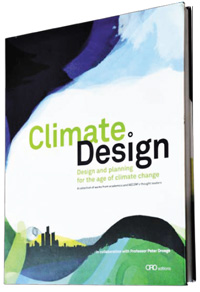Climate Design: Design and planning for the age of climate change. A book review.
 “In these current and impending times of climate change and environmental degradation, our consideration of integrated and holistic approaches to localised production of energy, water and food within the public urban system is critical.” This, and the fact that for us to stop destroying our planet irreversibly, we need to design with Nature and not against it, are the underlying themes of Climate Design: Design and planning for the age of climate change – A collection of works from academics and AECOM’s thought leaders.
“In these current and impending times of climate change and environmental degradation, our consideration of integrated and holistic approaches to localised production of energy, water and food within the public urban system is critical.” This, and the fact that for us to stop destroying our planet irreversibly, we need to design with Nature and not against it, are the underlying themes of Climate Design: Design and planning for the age of climate change – A collection of works from academics and AECOM’s thought leaders.
The volume goes beyond the mundane principles of how to design for energy efficiency or water conservation, and strikes at the very genesis of sustainable and responsible design principles and the approach to be adopted while creating developments or upgrading them. In this sense, Climate Design is not a book that would help engineers, architects and contractors with engineering guidelines. Rather, it inspires design philosophies, which, perhaps, have a far more over-arching positive impact than specific engineering design principles. These, in fact, sometimes tend to become too constricted, with a visible loss of the big-picture.
Of particular interest to design professionals is the acceptance of the fact that change is the only constant – or flux, as it is referred to here. Nature changes, incessantly. Climate change is not a surprise. It has been changing for thousands of years, and will continue to change. The focus, thus, should not be on how to stop this change or mitigating it. Climate Design, therefore, rightly focuses on designing and planning for this imminent change. The book showcases philosophies driving these designs and their applications – significantly supported by numerous successful case studies.
Design for climate change can only be successful if the focus shifts away from individual building developments to master-planned communities that inspire holistic and integrated development, resulting in socially interactive living. Integrated development must originate with design that is congruent with Nature and its systems, namely, wetlands and their financial benefits in reducing the requirement of artificial stormwater networks, local generation and availability of energy, water and food etc. It is critical to back all design recommendations by demonstrating their successful applications, and the book has done just that.
Above all, perhaps the most important contribution of this publication is to show the shift driver in design from the 20th century to the 21st century. In the 20th century, the consumer was at the receiving end of the type of land-use development decisions, mainly driven by their own desire to have “a large home with my own yard and room for my car”. This desire needs to change to “interested in a home in a community where I can live in a more sustainable way”. This will drive policy makers and governing agencies to align land planning and designing for climate change, resulting in private sector and developers to align their products to more sustainable lifestyles.
Sougata Nandi is Executive Director, Asset Management & Sustainable Development, with TECOM Business Parks Operations.
Available at:
Arif Books Distribution
(www.arifbooks.com, sales@arifbooks.com)
Price: AED 180/-
Copyright © 2006-2025 - CPI Industry. All rights reserved.